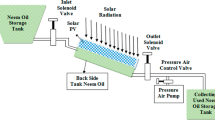Abstract
We propose an optimal cold sink temperature for thermoelectric dehumidifiers based on theoretical and experimental investigations. We show that the optimal condition is such that the latent heat absorption rate per unit power supplied to the dehumidifier is maximized. In consideration of the cooling ability of Peltier pellet and the heat exchange characteristics of the cold sink, we estimate the condensation rate as a function of the cold sink temperature. The theoretical predictions are compared with the results of experiments by using a prototype dehumidifier. We emphasize that the cold sink temperature is a critical parameter that determines the performance of dehumidification. Our study may provide an important insight to the thermoelectric dehumidification system and to designing a cold sink for thermoelectric dehumidifiers with improved energy efficiency.
Similar content being viewed by others
References
D. M. Rowe, Thermoelectrics, an environmentally-friendly source of electrical power, Renew. Energy, 16 (1–4) (1999) 1251–1256.
S. B. Riffat and X. Ma, Improving the coefficient of performance of thermoelectric cooling systems: A review, Int. J. Energy Res., 28 (9) (2004) 753–768.
S. B. Riffat and G. Qiu, Comparative investigation of thermoelectric air-conditioners versus vapour compression and absorption air-conditioners, Appl. Therm. Eng., 24 (14) (2004) 1979–1993.
K. Manohar and A. A. Adeyanju, Comparison of the experimental performance of a thermoelectric refrigerator with a vapour compression refrigerator, International Journal of Technical Research and Applications, 2 (3) (2014) 1–5.
S. B. Riffat and X. Ma, Thermoelectrics: a review of present and potential applications, Appl. Therm. Eng., 23 (8) (2003) 913–935.
P. K. Bansal and A. Martin, Comparative study of vapour compression, thermoelectric and absorption refrigerators, Int. J. Energy Res., 24 (2) (2000) 93–107.
C. Udomsakdigool, J. Hirunlabh, J. Khedari and B. Zeghmati, Design optimization of a new hot heat sink with a re-ctangular fin array for thermoelectric dehumidifiers, Heat Transfer Eng., 28 (7) (2007) 645–655.
H.-Y. Li and K.-Y. Chen, Thermal performance of plate-fin heat sinks under confined impinging jet conditions, Int. J. Heat Mass Transfer, 50 (9) (2007) 1963–1970.
D. Astrain, J. G. Vián and M. Domínguez, Increase of COP in the thermoelectric refrigeration by the optimization of heat dissipation, Appl. Therm. Eng., 23 (17) (2003) 2183–2200.
J. G. Vián and D. Astrain, Development of a heat exchanger for the cold side of a thermoelectric module, Appl. Therm. Eng., 28 (11) (2008) 1514–1521.
J. G. Vián and D. Astrain, Optimisation of a thermosyphon used to dissipate heat from a Peltier pellet, Domestic refrigeration application, J. Thermoelectr., 2 (2001) 55–68.
S. B. Riffat, S. A. Omer and X. Ma, A novel thermoelectric refrigeration system employing heat pipes and a phase change material: an experimental investigation, Renew. Energy, 23 (2) (2001) 313–323.
R. Chein and Y. Chen, Performances of thermoelectric cooler integrated with microchannel heat sinks, Int. J. Refrig., 28 (6) (2005) 828–839.
K. Chen, An analysis of the heat transfer rate and efficiency of TE (thermoelectric) cooling systems, Int. J. Energy Res., 20 (5) (1996) 399–417.
J. G. Vián, D. Astrain and M. Domínguez, Numerical modelling and a design of a thermoelectric dehumidifier, Appl. Therm. Eng., 22 (4) (2002) 407–422.
W. Huajun and Q. Chengying, Experimental study of operation performance of a low power thermoelectric cooling dehumidifier, Int. J. Energy Environ., 1 (3) (2010) 459–466.
Y. Hua, Z. Kang and Q. Chengying, Experimental investigation of operation characteristics of a thermoelectric dehumidifier, 3rd International Conference on Knowledge Discovery and Data Mining, IEEE (2010) 163–166.
C. Alaoui and Z. M. Salameh, Solid state heater cooler: Design and evaluation, Power Engineering. Large Engineering Systems Conference on. IEEE (2001) 139–145.
A. Lee, M.-W. Moon, H. Lim, W.-D. Kim and H.-Y. Kim, Water harvest via dewing, Langmuir, 28 (27) (2012) 10183–10191.
J. A. Chávez, J. A. Ortega, J. Salazar, A. Turó and M. J. García, SPICE model of thermoelectric elements including thermal effects, Proc. of the 17th IEEE Instrumentation and Measurement Technology Conference, 2 (2000) 1019–1023.
C. Alaoui, Peltier thermoelectric modules modeling and evaluation, Int. J. Eng., 5 (1) (2011) 114.
S. Lineykin and S. Ben-Yaakov, Modeling and analysis of thermoelectric modules, IEEE Trans. Ind. Appl., 43 (2) (2007) 505–512.
J. E. R. Coney, C. G. W. Sheppard and E. A. M. El-Shafei, Fin performance with condensation from humid air: A numerical investigation, Int. J. Heat Fluid Flow, 10 (3) (1989) 224–231.
ASHRAE Handbook, Fundamentals 2005, American Society of Heating, Refrigerating and Air Conditioning Engineers, Atlanta, USA (2005).
B. Kundu, Approximate analytic solution for performances of wet fins with a polynomial relationship between humidity ratio and temperature, Int. J. Therm. Sci., 48 (11) (2009) 2108–2118.
R. R. Rogers and M. K. Yau, A short course in cloud physics, Third Ed., Butterworth-Heinemann Press (1989).
G. Comini, C. Nonino and S. Savino, Numerical evaluation of fin performance under dehumidifying conditions, J. Heat Transfer, 129 (10) (2007) 1395–1402.
Author information
Authors and Affiliations
Corresponding author
Additional information
Recommended by Associate Editor Jae Dong Chung
Joonoh Kim received his B.S. degree from Korea University in mechanical engineering. He is currently a Ph.D. candidate in the Department of Mechanical Engineering at Seoul National University. His research interests include multiphase flows and spray dynamics.
Keunhwan Park received his B.S. and Ph.D. degrees from Seoul National University all in mechanical engineering. He is now a postdoc of physics at Technical University of Denmark. His research activities involve the domains of biological physics, evolutionary biology, cell biology, fluid dynamics and applied mathematics.
Ho-Young Kim received his B.S. degree from Seoul National University and M.S. and Ph.D. degrees from MIT all in mechanical engineering. He is now a Professor of mechanical engineering at Seoul National University. His research activities revolve around microfluid mechanics, biomimetics, and soft matter physics.
Rights and permissions
About this article
Cite this article
Kim, J., Park, K., Lee, DG. et al. Optimal cold sink temperature for thermoelectric dehumidifiers. J Mech Sci Technol 32, 885–895 (2018). https://doi.org/10.1007/s12206-018-0139-8
Received:
Revised:
Accepted:
Published:
Issue Date:
DOI: https://doi.org/10.1007/s12206-018-0139-8




